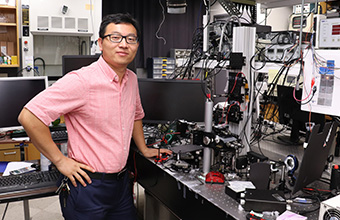College of Arts and Sciences Newsroom

Nano Manufacturing
The National Science Foundation has awarded two University of Dayton researchers $317,158 to study a new manufacturing process for building three-dimensional structures that are 1,000 times smaller than the diameter of a human hair.
The process developed by Chenglong Zhao and Qiwen Zhan is similar to 3D printing and uses a laser to assemble 100-nanometer-sized particles on a flexible substrate through precise electrical manipulation. Unlike current nanoscale fabrication techniques, it can be done under ambient conditions without expensive equipment, and doesn’t alter or damage the materials.
“We found a new transfer technology that allows you to transfer these nano-particles additively, with no damage to the nano-particles,” said Zhao, an assistant professor with a joint appointment in the Department of Physics and the School of Engineering’s electro-optics program. “You can just do this in the normal air.”
Reliable and cost-effective manufacturing of nanostructures and devices on flexible substrates has become increasingly important for the production of wearable devices, with a global market expected to reach $51 billion by 2022.
Additional applications could include sensors and other flexible electronics, biomedical markers and nanoscale robots.
The three-year NSF grant supports the fundamental study of this new manufacturing process. The award also supports the work of a doctoral student in Zhao’s research laboratory.
The goal is to develop the technology to enable rapid prototyping of both two- and three-dimensional nanostructures on flexible substrates. Zhao intends to prove the concept by fabricating nanostructures in his lab. Zhan will characterize the size and property of those structures.
“3D printing is widely used by engineers and designers for the rapid prototyping of customizable products,” said Zhan, a professor of electro-optics. “Unfortunately, such a rapid prototyping technique has yet to be developed for the manufacturing of nano-sized structures.”
Zhao said the importance of manufacturing at the nanoscale lies in the extraordinary properties that materials exhibit at such small scales, which is critical for exploring new material properties and applications.
For example, the color of nanoscale gold isn’t the familiar yellowish hue. Instead, it’s ruby red. The color shift, which involves changes to the way the surface electrons interact with light, only happens at nanoscales.
“This shows that you don’t need to change the chemical component of this material — just physically reduce the size and you change the property,” Zhao said.
Zhao is working with gold to prove his concept, but in principle, the process also could be used for other metals, such as aluminum.
Current laser-based nano-fabrication technology such as laser ablation can operate at ambient conditions. However, it requires a costly, high-power pulsed laser that bombs the material’s surface, destroying that surface in the process.
“Our method doesn’t do any damage to the nano-particle, which means you can transfer a particle as it is,” Zhao said. “If its shape is a sphere, it is still a sphere. If it is like a square, it’s still a square.”
Zhao joined the University of Dayton faculty in August 2015, and teaches mechanics and physics. His lab also focuses on the development of ultrasensitive bio-sensing technology.
In May, he received a University of Dayton STEM Catalyst grant with assistant professor of biology Yvonne Sun and assistant professor of chemical and materials engineering Erick Vasquez to detect and identify foodborne bacteria.
Zhao holds a doctoral degree in optics from Peking University and a bachelor’s degree in optics from Jilin University, both in his native China.
He plans to share his new research and technology with his physics students, in hopes of inspiring their interest in science and engineering.
“Dr. Zhao is still at the early stages of his career,” said John Erdei, associate professor and Department of Physics chair. “Receiving a grant through the National Science Foundation acknowledges the respect he has already achieved within the scientific community. This grant will further the scientific work of his research laboratory as well as increase the professional reputation of both Dr. Zhao and the Department of Physics.”
- Dave Larsen, communication coordinator, College of Arts and Sciences
